When (basic solution) is balanced, the sum of the coefficients of all the reactants and products is:
14
15
17
9
The correct Answer is:B
To balance the reaction Cr(s)+OH−(aq)→Cr(OH)−4(aq)+H2(g) in a basic solution, we will follow these steps:
Step 1: Identify Oxidation States
- Chromium (Cr) in solid form has an oxidation state of 0.
- In Cr(OH)−4, let the oxidation state of Cr be x. The hydroxide ion (OH−) has an oxidation state of -1 for oxygen and +1 for hydrogen. Thus, the total charge from 4 OH− is -4.
- The overall charge of Cr(OH)−4 is -1, so we have:
x+(−4)=−1⟹x=+3
- Therefore, Cr is oxidized from 0 to +3.
Step 2: Identify the Half Reactions
- Oxidation half-reaction:
Cr(s)→Cr(OH)−4(aq)+3e−
- Reduction half-reaction:
2H++2e−→H2(g)
Step 3: Balance Oxygen and Hydrogen
- To balance the oxygen atoms in the oxidation half-reaction, we add water (H2O):
Cr(s)+4H2O→Cr(OH)−4(aq)+3e−
- Now, we have 4 oxygen atoms on both sides.
Step 4: Balance Hydrogen
- We need to balance hydrogen by adding hydroxide ions (OH−):
Cr(s)+4H2O+4OH−→Cr(OH)−4+4H2O+3e−
- After balancing, we can simplify the equation.
Step 5: Combine Half Reactions
- To equalize the number of electrons, we multiply the reduction half-reaction by 3:
3H2O+6e−→3H2+6OH−
- Now, we can add the two half-reactions:
2Cr(s)+8OH−+6H2O→2Cr(OH)−4+3H2+6OH−
Step 6: Simplify and Finalize
- Cancel out the common terms:
2Cr(s)+2OH−+3H2O→2Cr(OH)−4+3H2
Step 7: Calculate the Sum of Coefficients
- Coefficients:
- Reactants: 2 (Cr) + 2 (OH−) + 3 (H2O) = 7
- Products: 2 (Cr(OH)−4) + 3 (H2) = 5
- Total sum = 7 + 5 = 12
Final Answer
The sum of the coefficients of all the reactants and products is 12.
---
- Chromium (Cr) in solid form has an oxidation state of 0.
- In Cr(OH)−4, let the oxidation state of Cr be x. The hydroxide ion (OH−) has an oxidation state of -1 for oxygen and +1 for hydrogen. Thus, the total charge from 4 OH− is -4.
- The overall charge of Cr(OH)−4 is -1, so we have:
x+(−4)=−1⟹x=+3
- Therefore, Cr is oxidized from 0 to +3.
- Oxidation half-reaction:
Cr(s)→Cr(OH)−4(aq)+3e−
- Reduction half-reaction:
2H++2e−→H2(g)
- To balance the oxygen atoms in the oxidation half-reaction, we add water (H2O):
Cr(s)+4H2O→Cr(OH)−4(aq)+3e−
- Now, we have 4 oxygen atoms on both sides.
- We need to balance hydrogen by adding hydroxide ions (OH−):
Cr(s)+4H2O+4OH−→Cr(OH)−4+4H2O+3e−
- After balancing, we can simplify the equation.
- To equalize the number of electrons, we multiply the reduction half-reaction by 3:
3H2O+6e−→3H2+6OH−
- Now, we can add the two half-reactions:
2Cr(s)+8OH−+6H2O→2Cr(OH)−4+3H2+6OH−
- Cancel out the common terms:
2Cr(s)+2OH−+3H2O→2Cr(OH)−4+3H2
- Coefficients:
- Reactants: 2 (Cr) + 2 (OH−) + 3 (H2O) = 7
- Products: 2 (Cr(OH)−4) + 3 (H2) = 5
- Total sum = 7 + 5 = 12
The sum of the coefficients of all the reactants and products is 12.
Topper's Solved these Questions
- BOOK - PHYSICS WALLAHCHAPTER - REDOX REACTIONSEXERCISE - NEET PAST 5 YEARS QUESTIONS12videos
REDOX REACTIONS
- BOOK - PHYSICS WALLAHCHAPTER - REDOX REACTIONSEXERCISE - LEVEL-140videos
REDOX REACTIONS
- BOOK - PHYSICS WALLAHCHAPTER - POLYMERSEXERCISE - NEET Past 5 Years Questions7videos
POLYMERS
- BOOK - PHYSICS WALLAHCHAPTER - SOLUTIONSEXERCISE - NEET PAST 5 YEARS QUESTIONS7videos
SOLUTIONS
Similar Questions
Cr(OH)3+IO3+OH−=I−+CrO2−4+H2O
View SolutionThe salt Zn(OH)2 is involved in the following two equilibria,
Zn(OH)2(s)⇔Zn+2(aq)+2OH−(aq),KspZn(OH)2=1.2×10−17
Zn(OH)2(s)+2OH−(aq)⇔[Zn(OH)4]2−(aq),Kc=0.13
Calculate the pH at which the solubility of Zn(OH)2 be minimum. Also find the solubility at this concentration.View Solution
Knowledge Check
- Question 1 - Select One
When the equation:
Cr2O2−7+H++I−→Cr3++I2
is balanced the correct coefficient for I− (aq) is :A8B6C10D3 - Question 2 - Select One
Amphoterism
Amphoteric oxides, such as aluminium oxide, are soluble both in strongly acidic and in strongly base solutions :
In acid:Al2O3(s)+6H3O+(aq)⇔2Al3+(aq)+9H2O(l)
In base:Al(OH)3(s)+OH−(aq)⇔Al(OH)−4(aq)
Dissolution of Al(OH)3 in excess base is just a special case of the effect of complex-ion formation on solubility.Al(OH)3 dissolves because excess OH− ions convert it to the soluble complex ion Al(OH)−4(aluminate ion)The effect of pH on the solubility of Al(OH)3 is shown in figure.
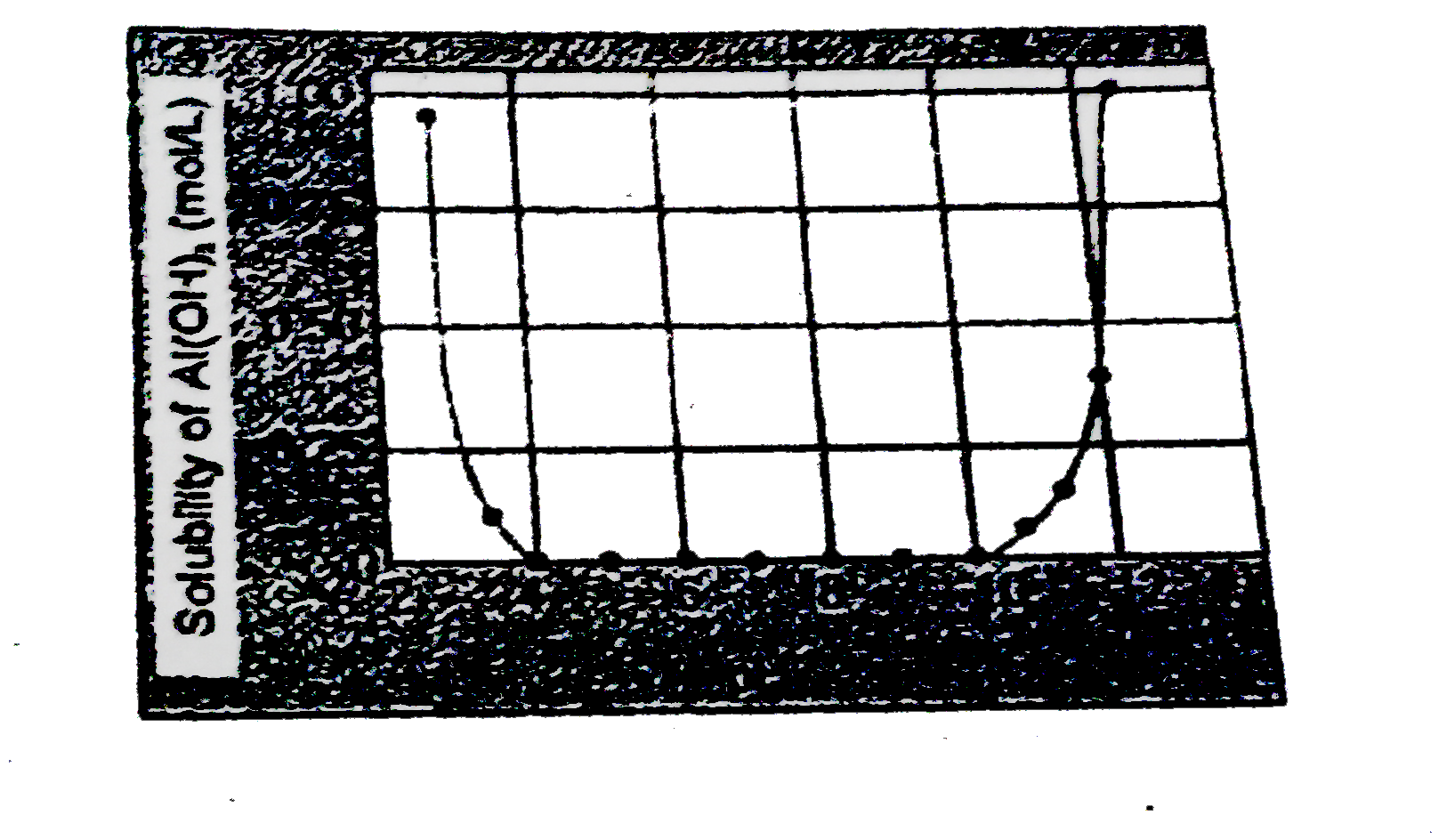
Other examples of amphoteric hydroxides include Zn(OH)2,Cr(OH)3,Sn(OH)2andPb(OH)2, which react with excess OH− ions to form the soluble complex ion Zn(OH)2−4(zincate ion),Cr(OH)−4(chromite ion),Sn(OH)−3 , Fe(OH)2andFe(OH)3 , dissolve in strong acid but not in strong base.
Which of the following curves best represents the variation of solubility of ferrous hydroxide Fe(OH)2 with the concentration of [H+] ions in the solution:A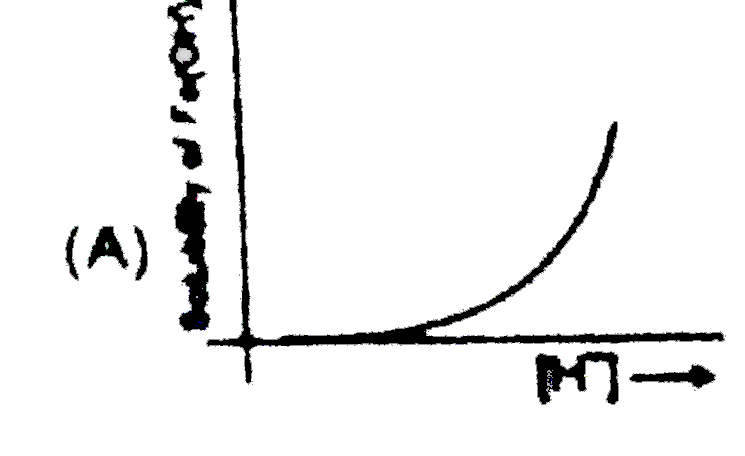 B
B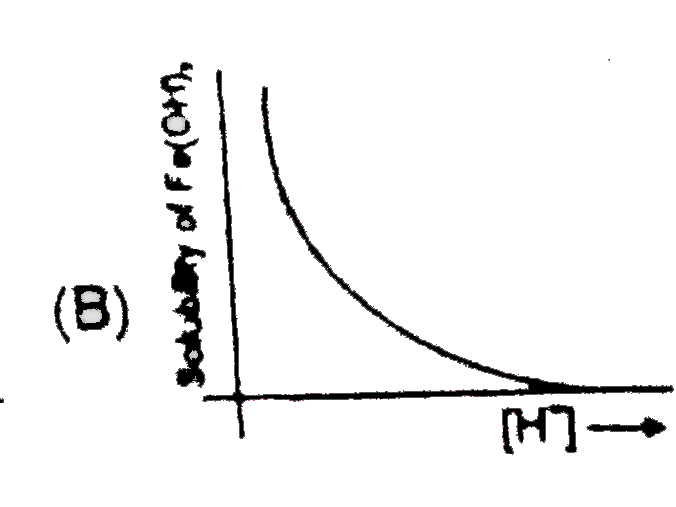 C
C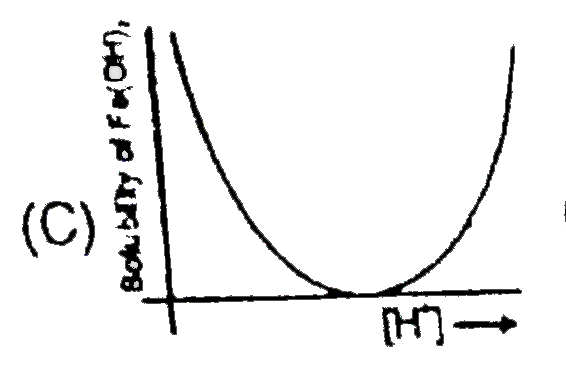 D
D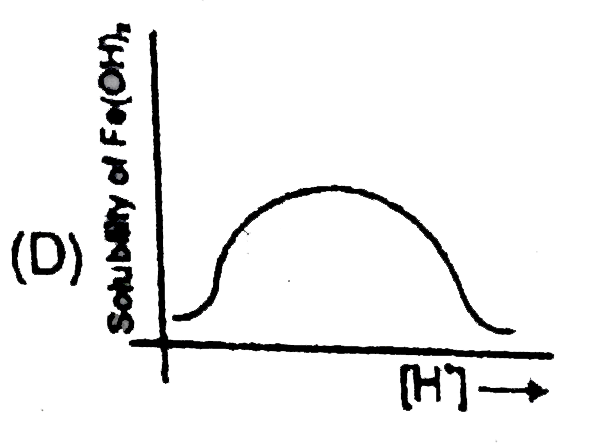
- Question 3 - Select One
Amphoterism
Amphoteric oxides, such as aluminium oxide, are soluble both in strongly acidic and in strongly base solutions :
In acid:Al2O3(s)+6H3O+(aq)⇔2Al3+(aq)+9H2O(l)
In base:Al(OH)3(s)+OH−(aq)⇔Al(OH)−4(aq)
Dissolution of Al(OH)3 in excess base is just a special case of the effect of complex-ion formation on solubility.Al(OH)3 dissolves because excess OH− ions convert it to the soluble complex ion Al(OH)−4(aluminate ion)The effect of pH on the solubility of Al(OH)3 is shown in figure.
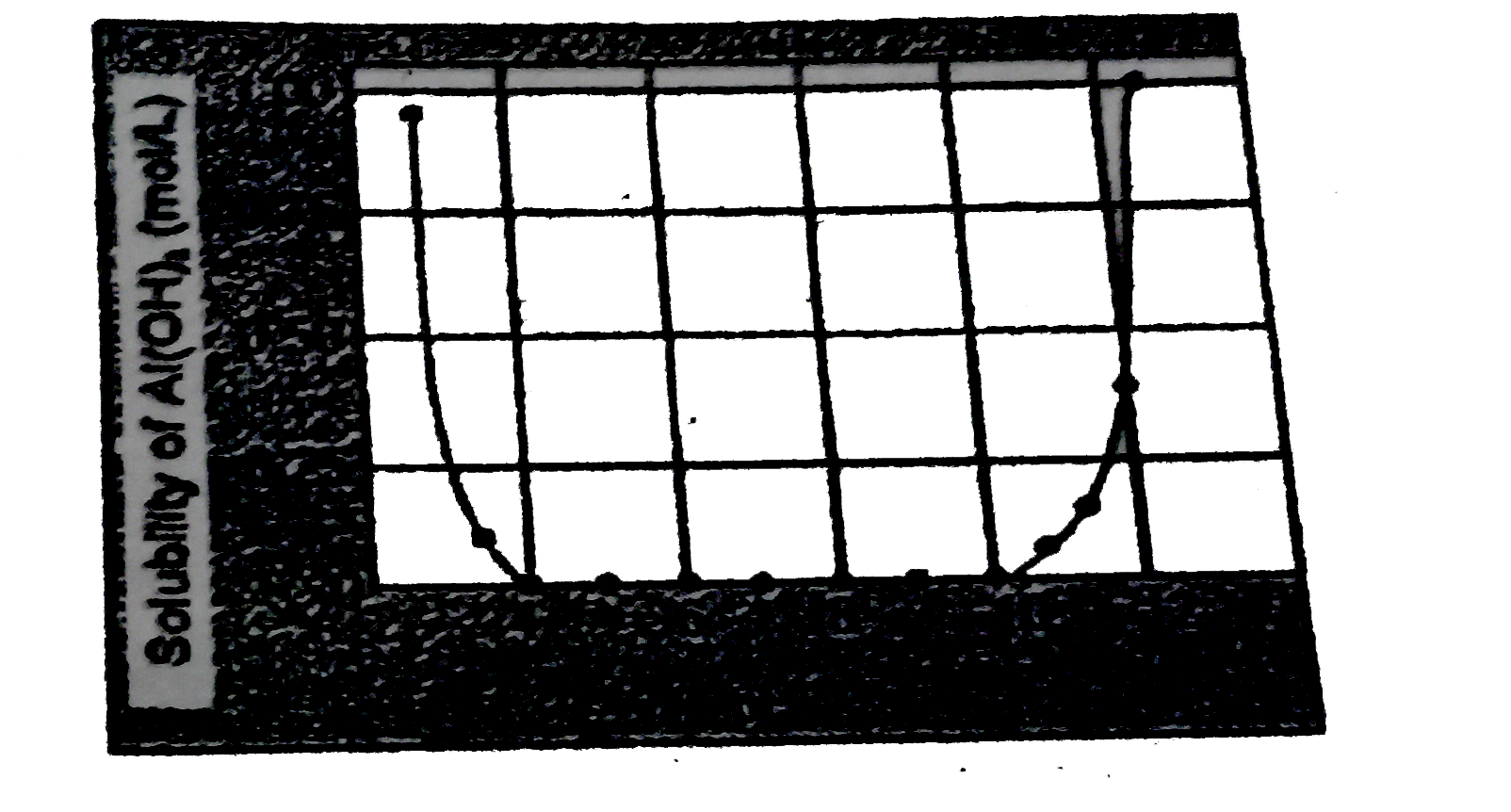
Other examples of amphoteric hydroxides include Zn(OH)2,Cr(OH)3,Sn(OH)2andPb(OH)2, which react with excess OH− ions to form the soluble complex ion Zn(OH)2−4(zincate ion),Cr(OH)−4(chromite ion),Sn(OH)−3 , Fe(OH)2andFe(OH)3 , dissolve in strong acid but not in strong base.
Zn(OH)2 is a amphoteric hydroxide and is involved in the following two equilbria in aqueous solutions
Zn(OH)2(s)⇔Zn2+(aq)+2OH−(aq),Ksp=1.2×10−17
Zn(OH)2(s)+2OH−(aq)⇔[Zn(OH)4]2−(aq),K∘=0.12
At what pH the solubility of Zn(OH)2 be minimum ?A4B10C6D8
For the redox reacton
Cr2O2+7+H++NI→Cr3++NI2++H2O
the correct coefficients of the reactants for the balanced reaction are
Cr2O2−7NIH+View SolutionThe unbalanced half equation,
CrO2−4(aq)→Cr(OH)−(aq) isView SolutionEthanol reacts with dichromate ion in acid solution according to the equation:
C2H5OH(l)+Cr2O2−7(aq)+H+(aq)→CO2(g)+Cr3+(aq)+H2O(l)
What is the coefficient for H+(aq) when this equation is balanced with the smallest whole number coefficients?View Solution__Sn2+(aq)+__NO−3(aq)+__H+(aq)→__Sn4+ (aq) +__NO(g)+ __H2O
What is the coefficent for H+ (aq) when the equation above is balanced correctly with the smallesr interger coefficients?View SolutionObserve the following reaction,
2NO2(g)+2OH−(aq)→NO−3(aq)+H2O(l)+NO−2(aq) in this reaction,View Solution

